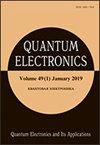估计波长为1.47、1.56和1.68 μm的最小激光功率,有效地消除静脉曲张
IF 0.9
4区 工程技术
Q3 Engineering
引用次数: 0
摘要
进行了静脉内激光闭塞术(EVLO)的模拟实验。结果发现,激光辐射能使整个静脉壁发生胶原变性、组织坏死和血管破坏,同时周围组织不会受到不必要的加热。测定P - c的主要标准是静脉壁蛋白的变性达到100%,并经形态学和量热分析证实。激光波长为1.47、1.56和1.68 μm时,P - c值分别为6.0±0.2、5.0±0.2和6.0±0.2 W。在使用的所有波长下,在相应的功率P C下,外静脉壁表面的温度达到91±2°C。我们将P C对辐射波长的依赖关系与光纤尖端在充满血液的血管中形成凝固联系起来。凝固形成所需温度的达到是由同时发生的能量吸收和能量以热的形式消散的过程决定的。随着介质吸收系数的增加,这些过程变得更加强烈。基于介质(血液)的吸收系数对光纤尖端附近温度的影响,提出了一种解释P - c值与激光波长之间关系的机制。本文章由计算机程序翻译,如有差异,请以英文原文为准。
Estimation of a minimum laser power with wavelengths of 1.47, 1.56, and 1.68 μm for efficient obliteration of varicose veins
Experiments modelling endovenous laser obliteration (EVLO) are performed. As a result, laser radiation powers P c at which collagen denaturation, tissue necrosis, and vasa vasorum destruction occur throughout the entire venous-wall thickness and, at the same time, the surrounding tissues are not subjected to unnecessary heating, are found. The main criterion for determining P c is the achievement of 100 % denaturation of venous-wall proteins, confirmed by morphological and calorimetric analysis. The P c values for laser wavelengths of 1.47, 1.56, and 1.68 μm are found to be 6.0 ± 0.2, 5.0 ± 0.2, and 6.0 ± 0.2 W, respectively. It is established for all wavelengths in use that the temperature of the external venous-wall surface reaches 91 ± 2 °C at the corresponding power P c. We relate the dependence of P c on the radiation wavelength to the formation of a coagulum on the optical fibre tip moving through a blood-filled vessel. The achievement of temperature necessary for coagulum formation is determined by the simultaneously occurring processes of energy absorption and its dissipation in the form of heat. These processes become more intense with an increase in the absorption coefficient of the medium. A mechanism is proposed to explain the relationship between the P c value and laser wavelength, based on the influence of the absorption coefficient of medium (blood) on the temperature near the fibre tip.
求助全文
通过发布文献求助,成功后即可免费获取论文全文。
去求助
来源期刊

Quantum Electronics
工程技术-工程:电子与电气
CiteScore
3.00
自引率
11.10%
发文量
95
审稿时长
3-6 weeks
期刊介绍:
Quantum Electronics covers the following principal headings
Letters
Lasers
Active Media
Interaction of Laser Radiation with Matter
Laser Plasma
Nonlinear Optical Phenomena
Nanotechnologies
Quantum Electronic Devices
Optical Processing of Information
Fiber and Integrated Optics
Laser Applications in Technology and Metrology, Biology and Medicine.
 求助内容:
求助内容: 应助结果提醒方式:
应助结果提醒方式:


